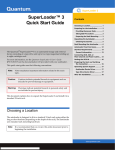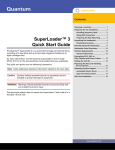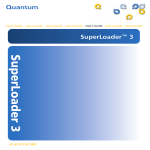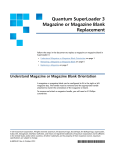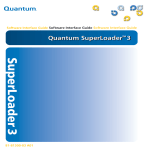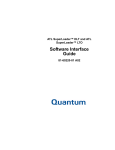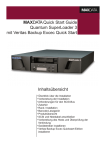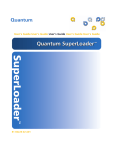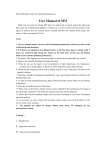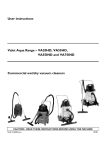Download Quantum SuperLoader 3A User`s guide
Transcript
SuperLoader 3A Series SuperLoader™ 3A Series Quick Start Guide Contents Choosing a Location.......................... 1 Preparing for the Installation........... 2 Providing Necessary Tools ............. 2 Taking ESD Precautions ................. 3 Preparing for Rack Mounting ........ 3 Unpacking the Autoloader................ 4 Checking Accessories ..................... 5 Rack Mounting the Autoloader ........ 6 Autoloader Panel Overviews........... 12 The Quantum® SuperLoader™ 3A Series autoloader is an automated storage and retrieval device with an integrated A-Series tape drive and up to two tape magazines holding up to eight cartridges each. It has a built-in FTP server and Web interface. For more information, see the SuperLoader 3A Series User’s Guide (PN 81-81643) and the A-Series FTP File Server User’s Guide (PN 81-81800) on the documentation CD provided with your autoloader. This quick start guide uses the following conventions: Note: Notes emphasize important information related to the main topic. Caution: Cautions indicate potential hazards to equipment and are included to prevent damage to equipment. Warning: Warnings indicate potential hazards to personal safety and are included to prevent injury. This document explains how to unpack the SuperLoader 3A Series autoloader and install it in a standard 19-inch rack. Choosing a Location The autoloader is designed to fit in a standard 19-inch rack using either the long or short brackets (depending on the depth of the rack). The autoloader uses standard rack mounting hardware. Note: It is recommended that you review this entire document prior to beginning the installation. Connecting Ethernet and Power Cables......................... 13 After the Installation....................... 14 0 SuperLoader™ 3A Series Quick Start Guide Choose a location that meets the following criteria: Criteria Description Rack requirements Standard 19-inch rack Room temperature 10–35° C (50–95° F) Power source AC power voltage: 100–127 VAC; 200–240 VAC Line frequency: 50–60 Hz Locate the AC outlet near the autoloader. The AC power cable is the product’s main disconnect device and must be easily accessible at all times. Weight 15.5 kg (34 lb.) unloaded 18.6 kg (41 lb.) loaded with 2 magazines, 16 cartridges Air Quality Minimize sources of particulate contamination. Avoid areas near frequently used doors and walkways, cooling or exhaust vents, stacks of supplies that collect dust, printers, and smoke-filled rooms. Excessive dust and debris can damage tapes and tape drives. Humidity 20–80% RH (non-condensing) Clearance Back: Minimum of 43.2 cm (17 in.) Front: Minimum of 68.6 cm (27 in.) Sides: Minimum of 5.08 cm (2 in.) Preparing for the Installation Before you begin the installation procedure in this section, make the following preparations as described in this section: Providing Necessary Tools 2 • Providing Necessary Tools • Taking ESD Precautions • Preparing for Rack Mounting 0Provide the following tools for unpacking and installing the autoloader: • #2 Phillips screwdriver • Level • Antistatic wrist strap Preparing for the Installation SuperLoader 3A Series 0Some components within the autoloader contain static-sensitive parts. To avoid damaging Taking ESD Precautions these parts while performing installation procedures, always observe the following precautions: • Ensure that the work area is free from conditions that could cause electrostatic discharge (ESD). • Discharge static electricity from your body by touching a known grounded surface, such as your computer's metal chassis. • Keep the autoloader turned off during all installation procedures. • Use an antistatic wrist strap. • Keep static-sensitive parts in their original shipping containers until ready for installation. Look for the ESD sticker to identify static sensitive parts. • Avoid touching connectors and other components. Note: Preparing for Rack Mounting 0 Dry climates and cold-weather heating environments have lower relative humidity and are more likely to produce static electricity. The autoloader can be rack mounted by attaching it directly to stationary cabinet rails. Take the following general safety steps before beginning the rack-mount installation. 1 Lower the cabinet feet. 2 Extend the cabinet anti-tip device, if available. Note: An anti-tip device may be extendable legs or similar equipment used to stabilize the cabinet. This anti-tip equipment is to help avoid overbalancing the cabinet when installing or removing equipment. 3 Ensure that the cabinet and all rack mounted equipment have a reliable ground connection. 4 Verify that the total current of all rack mounted components (including the autoloader) will not exceed the current rating of the power distribution unit or outlet receptacles. 5 Secure the help of at least one other person. At least two people are required to safely install the autoloader into a rack cabinet. Warning: Failure to take these safety steps may result in personal injury or equipment damage. Preparing for the Installation 3 SuperLoader™ 3A Series Quick Start Guide Caution: Do not remove the top cover of the autoloader during the installation process. Removing the top cover could result in damage to the autoloader. Unpacking the Autoloader Before you begin, clear a desk or table so that you can unpack the autoloader. The SuperLoader 3A Series Quick Start Guide has all the necessary information to unpack and inspect your autoloader correctly. You also need to select an open 2U computer rack location near the server that will host the autoloader. Caution: If the room in which you are working differs from the temperature in which the autoloader was shipped or stored by 15° C (30° F) or more, let the autoloader acclimate to the surrounding environment for at least 12 hours before removing it from the shipping carton. Caution: If your unit was ordered as a one-magazine autoloader, be sure to remove the plastic shipping insert from the magazine bay before connecting or operating your autoloader. Insert either a magazine or a magazine blank into the bay. The autoloader will not function without both magazine bays equipped with either a magazine or a magazine blank. Carefully unpack and inspect your new SuperLoader 3A Series autoloader by doing the following: 1 Inspect the shipping box for damage. If you notice any damage, report it to the shipping company immediately. 2 Open the shipping box and remove the accessories package. Set the accessories package aside for now. 3 Lift the autoloader and padding out of the box and place it on the work surface, top facing up. Do not set the autoloader on either end or sides. 4 Carefully remove the shipping padding from the left and right sides of the autoloader. Then remove the bag from the autoloader. 5 Remove the foam insert from the magazine bay of the autoloader. Save the packing materials in case you need to move or ship the autoloader in the future. Note: 4 If the cover must be taken off, there are 26 screws that need to be removed. Unpacking the Autoloader SuperLoader 3A Series Checking Accessories 0The following accessories are shipped with the SuperLoader 3A Series autoloader: • SuperLoader 3A Series Quick Start Guide • Ethernet cable • Hardware to rack mount the autoloader (see figure 1) • Four autoloader brackets (two long and two short to accommodate different rack depths) • Two support brackets • Two sets (decimal and metric) of four support bracket 10-32 x 1/4 inch button head screws (two per support bracket) • TORX® L-Key drivers (T8 and T10) • Power cable • Documentation CD containing all of the documentation in Adobe® Portable Document Format (PDF) • Bar code labels You will also need the following parts that were shipped with your rack: • Eight clip nuts • Eight rack screws Figure 1 Rack Mount Hardware Support brackets (74-60605-01) Short autoloader brackets (72-A225-A) Long autoloader brackets (72-A226-A) Support bracket screws 72-A348-A (4) or 90-60227-50 (4) Unpacking the Autoloader 5 SuperLoader™ 3A Series Quick Start Guide Rack Mounting the Autoloader This section provides the steps for attaching the autoloader directly to the stationary rails of a rack. Refer to table 1 for information on common rack hole types. Table 1 Rack Hole Types Figure Description Cage nut Square rack holes are the most common type of rack holes. They can accept either cage nuts which mount from the back of the rail or clip nuts which clip on from the side of the rack rail. Clip nut Clip nut Through holes require clip nuts to accept mounting hardware. Threaded holes require neither cage or clip nuts to accept mounting hardware. Note: The rails within the rack have a hole pattern that repeats throughout the rail. 1 Install two clip nuts, 1.75 in. (44.45 mm) apart, onto each of the four rails of the rack, making sure that you install each pair of clip nuts at exactly the same level (see figure 2). 6 Rack Mounting the Autoloader SuperLoader 3A Series Figure 2 Installing Two Clip Nuts Rail Rail Clip nut Outer covers of the rack 1.75 in (44.45 mm) Rail Clip nut 2 Select the long or short autoloader brackets (depending on the depth of the rack), and then attach them to the rear of the autoloader (see figure 3). Use the long autoloader brackets (72-A226-A) when the distance from the front mounting rail to the rear mounting rail is less than 30.25 in. (76.84 cm). Otherwise, use the short autoloader brackets (72-A225-A). Rack Mounting the Autoloader 7 SuperLoader™ 3A Series Quick Start Guide Figure 3 Attaching Autoloader Brackets Autoloader Screws (10-32 x 1/4 only) Autoloader bracket 3 Using rack screws, attach a support bracket to the clip nuts on each rear rail (see figure 4.) Note: Be sure to attach the support brackets correctly; the side of the bracket with only two holes should be secured to the rail. Tighten the screws just enough to hold the support brackets firmly against the rail while still allowing the support bracket to be slightly shifted by hand. This shifting will help facilitate the engagement of autoloader brackets as the autoloader is installed in the rack. You will fully tighten the screws in step 8. 8 Rack Mounting the Autoloader SuperLoader 3A Series Figure 4 Attaching Support Brackets Clip nuts Support bracket Rack screws Rear rail in rack Outer cover of rack 4 With the help of a second installer, insert the autoloader into the rack so that the autoloader brackets slide into corresponding support brackets on the rear rails and the tabs at the front of the autoloader align flush with the clip nuts on the front rails (see figure 5). Caution: Do not release the front end of the autoloader until it can be secured to the rack. Rack Mounting the Autoloader 9 SuperLoader™ 3A Series Quick Start Guide Figure 5 Sliding Autoloader into Rack Autoloader bracket Support bracket 5 While the other installer holds the front end of the autoloader, secure the front end of the autoloader to the rack using four rack screws (two per tab) as shown in figure 6. Tighten the screws just enough to secure the autoloader to the front rails. Figure 6 Front Alignment Front rail Autoloader (front) Rack screws Tab (one per side) 6 Install four screws (two per side) to secure the support brackets to the autoloader brackets (see figure 7). 10 Rack Mounting the Autoloader SuperLoader 3A Series Figure 7 Connecting Support Brackets Support bracket Autoloader bracket Screws 7 Verify that the autoloader is level. Adjust as needed. 8 When the autoloader is level, tighten all screws securing the autoloader to the rack. This includes the following: • Four screws securing the autoloader tabs to the front rails. • Four screws securing the support brackets to the rear rails. • Four screws securing the autoloader brackets to the support brackets. Rack Mounting the Autoloader 11 SuperLoader™ 3A Series Quick Start Guide Autoloader Panel Overviews The front panel allows you to configure the autoloader, enter commands, and obtain status information. Figure 8 Front Panel Overview 1 Power switch 2 Mailslot 3 Front panel LEDs 4 Front panel LCD screen 5 Function keys 6 Left magazine (or blank) 7 Right magazine (or blank) The Ethernet ports on the back panel allow you to connect to the A-Series tape drive FTP file server and to the autoloader remote management interface. Figure 9 Back Panel Overview 12 1 A-Series tape drive FTP file server Ethernet port 2 Fan vent 3 Power connector 4 Autoloader remote management Ethernet port 5 Power switch Autoloader Panel Overviews SuperLoader 3A Series Connecting Ethernet and Power Cables To connect the Ethernet and power cables to the autoloader, follow these steps: 1 Attach one end of the Ethernet cable (included in the accessory kit) to the tape drive Ethernet port on the back panel of the autoloader. 2 Attach the other end of the Ethernet cable to your host network port or router. 3 Attach the female connector of the power cable to the power connector on the back panel of the autoloader. 4 Plug in the power cable to the nearest properly grounded power outlet, then turn on the power switch on the back panel of the autoloader. Caution: Whenever you power cycle the autoloader, allow 10 seconds before turning the power back on. The power supply requires at least two to three seconds for the capacitors to discharge. This ensures a complete system reset on power down and may avoid system errors. 5 Turn on the autoloader by setting the power switch on the back panel to the ON position and pressing the power switch on the front panel. Check the LCD screen to make sure the autoloader is receiving power. If it is not, check the power connections and your power source. During the Power-on Self Test (POST), both LEDs are illuminated briefly, followed by only the Ready/Activity LED flashing. When the initialization sequence is complete, the LCD screen displays the Home screen. Note: The autoloader will not complete the initialization sequence unless both tape magazine openings are properly closed. You can use two magazines or one magazine and one magazine blank. Note: When the SuperLoader 3A Series is powered up, it undergoes a media inventory. Each tape cartridge in the autoloader is inserted into the A-Series tape drive and inventoried. Depending upon the number of cartridges in each magazine and the amount of content or data on each cartridge, the media cartridge inventory may take up to forty minutes. Connecting Ethernet and Power Cables 13 SuperLoader™ 3A Series Quick Start Guide After the Installation From the front panel of the autoloader, use the menus to set the IP address (DHCP or Static), Subnet Mask (if required), Gateway (if required), SNMP Server (optional), and Time Server (optional). The default IP address is 192.168.20.128. The default login and password for the On-board Remote Manager is guest and guest. For detailed information on the setup, operation, and administration of your system (including accessing and using the FTP file server), see the SuperLoader 3A Series User’s Guide (PN 81-81643) and the A-Series FTP File Server User’s Guide (PN 81-81800) on the documentation CD provided with your autoloader. *81-81667-02 A01* 81-81667-02 A01 For assistance contact Quantum Technical Assistance center: North America +1-800-284-5101 UK, France, and Germany 00800 4 QUANTUM EMEA +44 1256 848 766 For worldwide support: www.quantum.com/contactsupport Quantum Corp. (NYSE: QTM) is the leading global storage company specializing in backup, recovery and archive. Combining focused expertise, customer-driven innovation, and platform independence, Quantum provides a comprehensive range of disk, tape, media, and software solutions supported by a world-class sales and service organization. As a long-standing and trusted partner, the company works closely with a broad network of resellers, OEMs, and other suppliers to meet customer’s evolving data protection needs. Backup. Recovery. Archive. It’s What We Do. ©2007 Quantum Corporation. All rights reserved. Quantum, the Quantum logo, and all other logos are registered trademarks of Quantum Corporation or their respective owners. 81-81667-02 A01 August 2007














